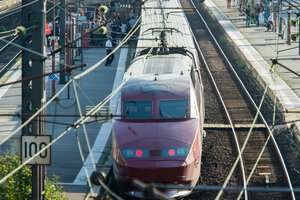Thwarted French train attack highlights scant rail security against terror acts
Friday’s attack on a train traveling from Amsterdam to Paris has drawn attention to the potential terror threat facing rail networks.

A Thalys train stands at the main train station in Arras, northern France, after a gunman opened fire injuring three people, Friday, Aug. 21, 2015. A spokesman for France's interior ministry says three people were wounded in a shooting on a high-speed train traveling from Amsterdam to Paris Friday.
AP Photo/File
Authorities are questioning the man accused of Friday’s attempted attack on a high-speed train between Amsterdam and Paris.
Moroccan Ayoub El-Khazzani, who is suspected of storming a passenger Thalys train with an automatic Kalashnikov-style rifle, is said to have ties to the “radical Islamic movement,” according to the BBC. Officials continue to investigate whether Mr. El-Khazzani acted alone or with an accomplice, and “if there is possibly a wider framework involved,” NBC News reports.
The incident, which has once again highlighted the potential security threat of European and American jihadis returning from Syria and Iraq, has also drawn attention to the growing vulnerability of rail networks to acts of terror. According to the Irish Independent:
Despite armed police patrolling stations across the world, experts have long feared that rail networks were particularly vulnerable to a terrorist attack. Between 2002 and 2011 there were 203 deaths on aircraft that were attributable to acts of malice. On trains and mass transit there were 804.
In an analysis of terror attacks from 1982 to 2011, Arnold Barnett, a researcher from the Massachusetts Institute of Technology, found “strong and statistically significant evidence that successful acts of terror have ‘gone to ground’ in recent years: attacks against aviation were concentrated early in the three decades studied whereas those against rail were concentrated later.”
One reason is that terrorists may consider railways more effective targets. The brave actions of the three Americans who thwarted Friday’s attempted assault notwithstanding, “attacks on rail are far less likely to be stopped once in progress,” Dr. Barnett wrote.
Indeed, two weeks after the 2005 suicide bombings on the London underground, a very similar attack also involving three trains was attempted there. Although the plot failed because the explosives were faulty, no precautions after the earlier event succeeded in averting a near-recurrence.
Still, Barnett – as other experts have before him – also emphasized that the actual risk of being on either a plane or a train during a terrorist attack is miniscule. But he noted that recognizing the shift in terrorist strategy may help inform security policy around railway systems in the US, Europe, and elsewhere.
In response to Friday's attack, mixed Franco-Belgian security patrols will be stepped up aboard Thalys trains, which connect major cities in the Netherlands and Belgium to Paris, Belgian authorities said following a meeting of its national security council Saturday, according to the BBC. Security checks and patrols will also be increased at international train stations and more baggage checks will be carried out.
Witnesses say the suspect, who boarded the train in Brussels, emerged from a restroom carrying an assault rifle, a handgun, and a knife, The Christian Science Monitor reported.
One passenger was shot. Several passengers received knife wounds as the attacker moved through the train, at which point the Americans intervened, tackling the suspect, beating him unconscious, and tying him up. A British man, Chris Norman, jumped in to help subdue the attacker.
El-Khazzani, who lived in Spain until 2014 before moving to France, traveling to Syria, and then returning to France, was flagged by Spanish authorities last year for links to Islamic radical movements, according to the Associated Press.

